Yellowstone - nexus of beauty and danger
By Pramod De Silva
|
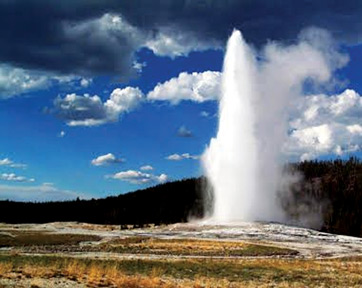
Old Faithful Geyser |
Yellowstone. The very name conjures up images of geysers, thermal
springs, bison, majestic waterfalls, rivers, mountains and vast scenic
landscapes. But there is another word associated with Yellowstone that
is not so reassuring: Volcano. Yes, Yellowstone National Park, the
oldest declared national park in the world (1872), sits atop one of the
world’s largest super-volcanoes that can potentially cause enormous
damage over much of the United States.
In fact, Yellowstone was struck last month by a magnitude 4.8
earthquake, the biggest recorded there since February 1980, but no
damage or injuries were immediately reported. The tremor, a relatively
light event by seismic standards, struck the Northwest corner of the
park. The quake occurred near the centre of an area of ground uplift
that geologists have been tracking for several months, About 1,000 to
3,000 earthquakes strike Yellowstone each year, according to the
Yellowstone Volcano Observatory, a research partnership of the Park, the
University of Utah and the U.S. Geological Survey.
Biggest volcanoes
The words volcano and earthquake were very much on my mind as I
toured Yellowstone recently with my wife as the guide constantly
reminded us that we were walking atop one of the world’s biggest
volcanoes. It felt as if we had stepped onto another planet - the
landscape around you is so out of this world, literally. Not
surprisingly, scientists hoping to see life on alien planets study
micro-organisms that thrive in Yellowstone’s hot springs.
You can tour Yellowstone for a lifetime and still learn new things
every day since the national park spans 3,472 square miles (8,992 square
km) of Wyoming, Montana and Idaho. It draws about three million visitors
each year from all over the world to its well known geysers and wildlife
attractions, including bison. The ancient super-volcano, or caldera,
that lies beneath the surface of the park was discovered by scientists
in recent years to be 2.5 times larger than previously thought, measured
at 50 Km wide.
|
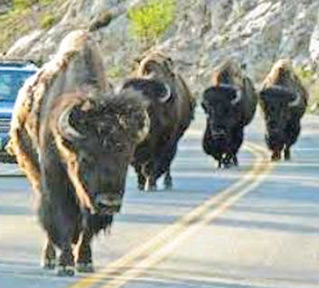
Bison on the highway |
The good news is there was no indication that the recent seismic
activity signalled an impending eruption of the Yellowstone Caldera. The
bad news is that it might happen one day, may be not in our lifetimes.
With reports of bison fleeing the area after the most recent
earthquake, some had predicted a massive eruption, but scientists
dismissed the idea. In any case, when in Yellowstone, do stick to the
park officials’ advice not to veer away from the designated paths and
trails as the ground is unstable.
During the extensive tour of Yellowstone, I learned that catastrophic
eruptions of the super-volcano are unlikely for tens of thousands of
years, though less extreme lava releases could occur within thousands of
years. According to the park’s naturalists, the super-volcano’s most
cataclysmic eruption occurred nearly two million years ago, covering
half of North America with ash. The eruption probably killed animals
living as far away as modern-day Nebraska. If such an event were to
occur today, one can imagine the scale of loss of life and destruction.
Stunningly beautiful
But that does not negate the fact that Yellowstone is stunningly
beautiful in all seasons. We toured the park at the tail end of summer,
but the park takes a life of its own even in the depths of winter. The
park has a number of outstanding geothermal features, but the most well
known is the geyser known as “Old Faithful” which alludes to the fact
that it shoots water into the air at regular intervals. When you enter
Yellowstone, just check the visitor centre bulletin board for the next
‘eruption’. Generally, you do not have to wait for more than 40 minutes.
While Old Faithful is the most spectacular geyser, there are around 500
less well known geysers throughout the park.
But how are they generated? Heat from a vast chamber of molten rock
beneath the caldera fuels the park’s famous geothermal features,
including Old Faithful Geyser. The other most famous feature in
Yellowstone is the Grand Prismatic Spring, which is a riot of colour
that dazzles the eyes. At 250-by-300 feet and up to 160 feet deep, the
Grand Prismatic Spring is the largest hot spring in the USA. Its
brilliant colours are the result of pigmented bacteria living on its
perimeter. The hues change and become more or less vibrant depending on
the kinds of bacteria thriving at any given time.
|
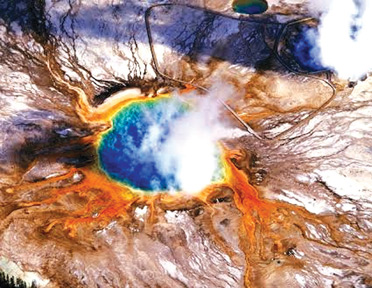
Prismatic Spring |
The heat of the spring - it’s 72 degrees Celsius at the center -
causes steam to waft and swirl, adding to the alien look of the place.
Scientists are studying the bacteria in the hope of gaining of an
understanding whether other planets could harbour extreme forms of life
that can thrive in otherwise toxic environments. Again, there are a few
other such hot springs dotted throughout Yellowstone, though none match
the Grand Spring for sheer splendour.
Unmissable feature
Waterfalls are another unmissable feature at Yellowstone. There are
more than 45 named waterfalls and a few more unnamed ones. The highest
plunge type waterfall in the park is the lower Falls at 308 feet (94 m).
The highest horsetail type is Silver Cord Cascade at 1,200 feet (370 m).
The latter is a huge spectacle, admired from some distance away. The
waterfalls are associated with a number of rivers that add beauty to the
park.
If you go on safari in Sri Lanka, you do not want to miss seeing an
elephant. The Yellowstone equivalent is the bison, which is now thriving
in several parts of the US. In fact, our tour bus had to go rather
slowly to give way for a herd of bison crossing the road. It is a
traffic-stopping scene, with these proud animals slumbering along the
highway that goes by Yellowstone. There are more than 3,700 bison in
Yellowstone, so you will not miss them.
Among the other animals that call Yellowstone home are bighorn sheep,
elk, wolves, bears (notoriously difficult to see), moose and pronghorn.
Indeed, Yellowstone is a geological as well as wildlife marvel that you
cannot afford to miss if you visit the USA. As the plaque at one of the
entrances says, Yellowstone is “for the benefit and enjoyment of the
people”.
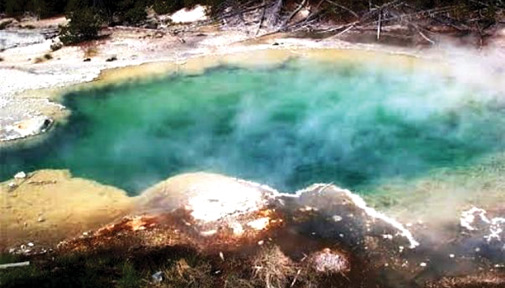 |
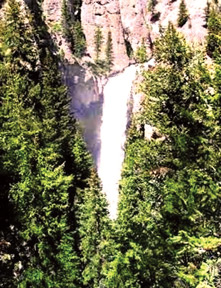 |
| A thermal spring |
A majestic waterfall |
|

